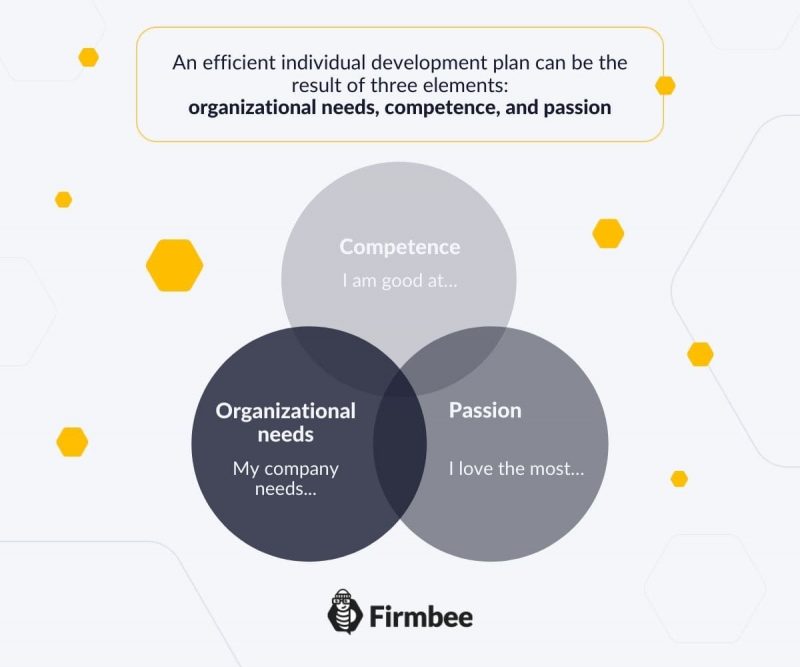One of the demands of today’s workplace and a challenge for managers is the expectation that all employees will have certain opportunities for professional development available to them at their place of employment. Contemporary employees see to grow in their jobs and choose to stay with employers, who enable them to do so. It has become a common practice for managers to introduce development programs devised especially for their employees.
Individual development plans – table of contents:
- What is an individual development plan?
- How to create an individual development plan?
- Key elements of an individual development plan?
- Benefits for the company of individual development planning
- Benefits for the individual of having an individual development plan
What is an individual development plan?
The Individual Development Plans (IDPs) may be seen as tools complementary to other processes such as: annual performance reviews, satisfaction measurements, or training tasks.
There are two types of individual development plans (IDPs).The first is created by the employee himself for his own use. Such plan allows the employee to design his work future in grater detail. It is a written down vision of personal career accompanied with an information about his goals, skills, and required actions. It should help the individual to search for their dream job and identify gaps in education or knowledge required for the desired role.
The second type of individual development plan is created by the employee in cooperation with his manager or other HR professional. The aim of this plan is similar to the personal one – to design future career and set goals, but in this case, within the company. It is extremely beneficial for the company to devise individual development plans for its employees because it connects to some extent employee’s hopes and intentions with company’s mission and objectives.

How to create an individual development plan?
The process of creating of an individual development plan is not difficult but involves frequent interaction between the supervisor and the employee. A lot of matters must be discussed therefore good communication is crucial during this process.
There are steps of the process, which have to be taken to create efficient individual development plan. First stage of pre-planning requires the individual and the manager to prepare themselves independently before their meeting. The individual should reconsider his goals and skills, while the manager has to prepare the suggestions and opportunities for employee’s training.
During the next stage – the meeting – both parties discuss employee’s goals, strengths, weaknesses, interests, and needs. All this is essential for the next stage of designing the individual development plan, where completed plan is written down and gets the acceptance of both the employee and the manager.
In the next stage of implementation, employee has to take necessary training, gain knowledge or achieve certain experience as it was elaborated in the individual development plan.
The last stage is assessment, where both the employee and the manager evaluate usefulness of actions taken during the training phase.
Key elements of an individual development plan?
Individual development plan must have at least several basic components, but it may be customized accordingly to each employee’s needs and abilities. Among the most crucial elements of simple individual development plan are:
- Employee’s profile – where all the details of the individual are recorded alongside with his position, education, and qualifications.
- Career goals – each goal may be accompanied with short explanation of the necessity for its achieving and how it may benefit the company as a whole. Both short-term and long-term goals may be recorded in that section, the dates of predicted completion is necessary as well.
- Activities – actions related to goals stated in the previous section, those activities should be relevant to company mission and be presented in the form of neat schedule for the employee to follow. Here all training sessions and development procedures may be included as well. Not all the training has to be formal – web-based training, job shadowing, on-the-job training, professional seminars, and self-study programs are also acceptable.
- Assessment of progress – all completed activities have to be recorded in the last part of the document to check if any progress has been made. The last section should show all the accomplished goals and summarize the process.

Benefits for the company of individual development planning
There are several key benefits for the company related to creation of individual development plans (IDP) for its employees such as:
- Quick identification of all short-term and long-term goals of the employee,
- Registration of all strengths and helps with recognition of gaps in employee’s skills, knowledge, or experience,
- Provision of visual representation of time spend working on chosen goals,
- Improvement of communication between the employee the representatives of the company (HR professionals, managers, advisors),
- Retention of written confirmation of accomplishment and development,
- Encouragement to reflection and self-assessment of career path and life choices,
- Connection of employee’s intentions with company’s objectives,
- Facilitation of planning for training programs provided by the company,
- Tidy and clear track of overall development of employees alongside their needs and goals.
Benefits for the individual of having an individual development plan
Each individual should consider writing of an own individual development plan. It helps greatly with self-improvement and allows to see own life in broader perspective. Generally, there are four benefits any rational person may gain from having an individual development plan and those are:
- Ability to discover own life’s purpose – it is not easy to find a true calling, but each act of mental inspection of own life brings better insight into our reality and deep needs.
- Development of personality – the bond between personality and achievement is strong and there are no doubt about it. Any individual wishing to progress in life should spend some time on personal growth. Communicative skills, confidence and mental health cannot be taught in the classroom and one has the responsibility to take care of them by his own means.
- Sense of direction – knowing exactly our life goals facilitates decision making processes, allows to concentrate on important goals and helps to leave behind all irrelevant matters.
- Self-actualization – realization of one’s potential and full development of one’s abilities may be achieved only through determination, commitment and focus.
Individual development plans are beneficial both for employees and their employers. In many contemporary companies there are policies implemented in HR departments, which expect each employee to have an own individual development plan.
Having clear personal goals and access to training opportunities provided by the employer gives any employees a chance for promotion, as well as sense of belonging and purpose. Those elements are crucial for employee’s motivation and satisfaction so they have to be cared for.
Read also: Development paths in HR
If you like our content, join our busy bees community on Facebook and Twitter.
Author: Nicole Mankin
HR manager with an excellent ability to build a positive atmosphere and create a valuable environment for employees. She loves to see the potential of talented people and mobilize them to develop.


















